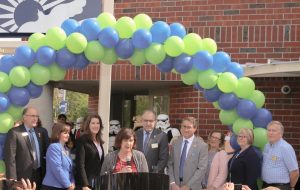Driverless buses “drive” tech innovation into San Ramon
April 28, 2018
In early March, Bishop Ranch and Contra Costa County Transportation Authority granted permission for California’s first driverless bus to be tested on the streets of San Ramon in an attempt to reduce the expenses of the city transportation.
The driverless bus, also known as an autonomous vehicle, is capable of sensing its environment and navigating through an area without human input. It is programmed beforehand with computers and sensors to help it function.
The driverless bus contains electric brakes and drivers along with a previously programmed route to run. It also has the accessories such as sensors to detect any dangerous object in front which alerts it to stop.
“This is one of the first ones to have no brake and no steering wheel, but the routes are all programmed in,” said San Ramon Mayor Clarkson.
Around the beginning of March, the autonomous vehicle traveled on a public street for the first time. It was programmed a route between Bishop Ranch 2600 and 6 to do its main run.
The autonomous bus is definitely less expensive than a regular human-operated vehicle. Firstly, there is no driver cost which allows more frequent stops and more passengers to use public transportation.
“Now, you use cell phones all the time because it is less expensive. Same to do with the transportation of the states,” said Clarkson, regarding the purpose of the autonomous bus.
Currently, the bus systems in San Ramon are not very efficient, as the fastest ones arrive at a stop every thirty minutes. In contrast, in large, metropolitan urban areas such as San Francisco, there is an abundance of public transportation systems which have a frequency of almost every ten minutes. Because of this significant difference in efficiency, many passengers use buses and trains rather than cars in San Francisco.
The driverless bus still remains in its trial stage during this period of time. As a result, Contra Costa County Transportation Authorities have not yet granted permission to spread the usage of the driverless bus beyond Bishop Ranch in San Ramon.
According to Mayor Clarkson, the bus has not caused any accidents during its early testing stage. However, the possibility of any disaster occurring in a future due to this technological invention still looms, as even the smallest human error in programming a route or building any sensors can lead to unfortunate injuries or even deaths. As a result, the autonomous bus in San Ramon is clearly not exempt from the possibility of any future accidents.
On Sunday, March 18, a self-driving Uber car which also contained an emergency backup driver behind the wheel killed a woman pedestrian in Tempe, Arizona, exhibiting the severe flaws that may exist in human-operated robots. After this mishap, the testing of autonomous vehicles was suspended in Tempe, Pittsburgh, San Francisco, and Toronto.
Bishop Ranch, the large business park in San Ramon, purchased the driverless bus and even gave the city permission to test the vehicle on their ground. They were the primary player in the successful trials of the bus. Contra Costa County Transportation Authority then gave the City of San Ramon the official authorization to run tests of the autonomous bus.
According to Mayor Clarkson, the benefits of the driverless bus is most clearly explained in a cell phone analogy. A few decades ago, long distance calls always went through operators and cost approximately three dollars per minute to conduct. Through modern day technology, it is absolutely free to do any long distance call as the user is already paying a fixed rate per month for cell phone usage. Similarly, the autonomous bus provides San Ramon with a more efficient transportation option. It can run routes more consistently than current buses with the added benefit of a reduced cost.
“If you can take a bus down to say, City Center, for a future job or your school, and it costs a dollar and a bus comes every ten minutes, you don’t need a car to do a lot of commute in San Ramon,” said Mayor Clarkson, on the benefits of a driverless bus. “The efficiency is that it drives down the cost.”
Unfortunately, the City of San Ramon doesn’t currently know surely when the autonomous bus will be implemented for public use. However, the tests have produced positive results so far which gives hope that this new technology will shortly begin to function frequently.


